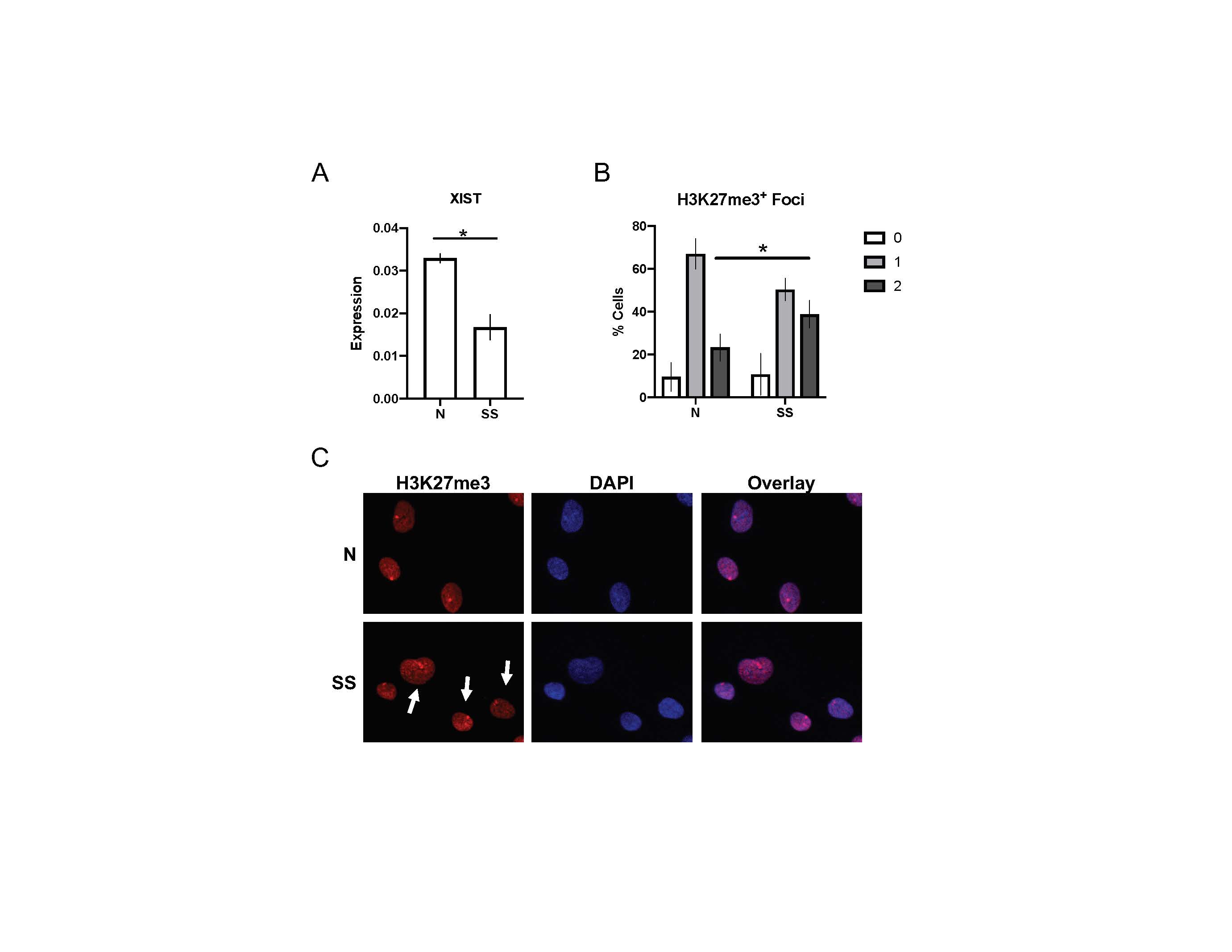Session Information
Session Type: Abstract Session
Session Time: 4:00PM-4:15PM
Background/Purpose: Many autoimmune diseases feature increased prevalence in females, with primary Sjögren’s syndrome (pSS) being the most female-predominant autoimmune disease with a female-to-male ratio of 14:1. Recent evidence suggests that the presence of two X chromosomes may underlie the female bias in pSS. However, the exact X chromosomal alterations on a single-gene level in pSS and their contribution to the female bias in pSS remain elusive. The objective of this study is to define the contribution of X-linked gene expression to pSS pathogenesis, focusing on minor salivary gland-derived mesenchymal stromal cells (MSCs) which are critical players maintaining salivary gland homeostasis.
Methods: Genome-wide, allele-specific expression profiling was performed using MSCs derived from female pSS subjects meeting 2016 ACR/EULAR criteria (n=4) and female control subjects with sicca symptoms but without clinical or laboratory features of autoimmunity (n=4). qRT-PCR of XIST (X-inactive-specific transcript) and quantitative immunostaining of H3K27me3 were performed to assess status of X-chromosome inactivation (XCI) in pSS and control MSCs. Protein localization was analyzed by quantitative immunofluorescence in pSS and control MSCs. Expression levels of IL4 were measured by qRT-PCR before and after MSC adipogenesis to assess the immunomodulatory properties of MSCs. Student’s t-test (two-sample, unequal variances) was used to compare experiment versus control groups for statistical significance.
Results: All pSS MSCs analyzed demonstrated marked skewing of X-linked genes that escape XCI (i.e. escapees), while all control MSCs exhibited balanced escapee expression (Fig. 1). Concomitantly, pSS MSCs showed decrease in XIST expression levels (P < 0.05) and reorganization of heterochromatic, silencing foci in the nucleus (P < 0.05), suggesting a global disruption in XCI maintenance (Fig. 2). The skewing in X-inactivation escape in pSS MSCs was accompanied by mislocalization of protein products encoded by the escapees as well as inflammatory differentiation of MSCs (P < 0.05), consistent with the hallmark features of inflammation and fibrosis in pSS salivary glands (Fig. 3).
Conclusion: We discovered global skewing of X-linked genes in pSS but not control MSCs, and identified escapee skewing as a new mechanism underlying pSS pathogenesis. Given that XCI is a female-specific process, our data suggests that dysregulation of XCI escape contributes to the female bias in pSS.
 Figure 1. pSS MSCs demonstrate marked X skewing. Allele-specific transcriptomic profiling of control (N1 – N4) and pSS (SS1 – SS4) female MSCs, showing MAF (minor allele frequency) of heterozygous common SNPs on each chromosome. MAF of ~0.5 suggests equal contribution from maternal and paternal alleles, while MAF < 0.4 suggests skewing. For each sample, MAFs are shown for each chromosome (chromosomes 1_22, X; from left to right), with arrows pointing to MAFs on chromosome X (black for control, red for pSS).
Figure 1. pSS MSCs demonstrate marked X skewing. Allele-specific transcriptomic profiling of control (N1 – N4) and pSS (SS1 – SS4) female MSCs, showing MAF (minor allele frequency) of heterozygous common SNPs on each chromosome. MAF of ~0.5 suggests equal contribution from maternal and paternal alleles, while MAF < 0.4 suggests skewing. For each sample, MAFs are shown for each chromosome (chromosomes 1_22, X; from left to right), with arrows pointing to MAFs on chromosome X (black for control, red for pSS).
 Figure 2. pSS MSCs exhibit XCI defects. A, qRT-PCR of XIST expression levels in control (N) and pSS (SS) MSCs. B, quantification of cells with 0, 1, and 2 H3K27me3+ nuclear foci in control (N) and pSS (SS) MSCs. C, immunofluorescence images of H3K27me3 and DAPI staining of control (N) and pSS (SS) MSCs, with arrows pointing to pSS cells with ectopic H3K27me3+ foci. Mean ± sem, * P < 0.05, two-tailed Student’s t-test.
Figure 2. pSS MSCs exhibit XCI defects. A, qRT-PCR of XIST expression levels in control (N) and pSS (SS) MSCs. B, quantification of cells with 0, 1, and 2 H3K27me3+ nuclear foci in control (N) and pSS (SS) MSCs. C, immunofluorescence images of H3K27me3 and DAPI staining of control (N) and pSS (SS) MSCs, with arrows pointing to pSS cells with ectopic H3K27me3+ foci. Mean ± sem, * P < 0.05, two-tailed Student’s t-test.
 Figure 3. Escapee skewing in pSS MSCs is accompanied by escapee protein mislocalization and MSC inflammatory differentiation. A, immunostaining of a representative escapee, CHST, in control (N) and pSS (SS) MSCs. Arrow points to CHST+ nuclear foci that are absent in pSS MSCs. B, quantitative nuclear foci analysis in control (N) and pSS (SS) MSCs. C, qRT-PCR of IL4 in undifferentiated (Undiff) and differentiated (Diff) control (N) and pSS (SS) MSCs. Mean ± sem, * P < 0.05, two-tailed Student’s t-test.
Figure 3. Escapee skewing in pSS MSCs is accompanied by escapee protein mislocalization and MSC inflammatory differentiation. A, immunostaining of a representative escapee, CHST, in control (N) and pSS (SS) MSCs. Arrow points to CHST+ nuclear foci that are absent in pSS MSCs. B, quantitative nuclear foci analysis in control (N) and pSS (SS) MSCs. C, qRT-PCR of IL4 in undifferentiated (Undiff) and differentiated (Diff) control (N) and pSS (SS) MSCs. Mean ± sem, * P < 0.05, two-tailed Student’s t-test.
To cite this abstract in AMA style:
Shaw T, Zhang W, McCoy S, Qiu X, Pagenkopf A, Scofield R, Galipeau J, Liang Y. Skewed Escape from X-inactivation: Insights into the Female Bias of Sjögren’s Syndrome [abstract]. Arthritis Rheumatol. 2021; 73 (suppl 9). https://acrabstracts.org/abstract/skewed-escape-from-x-inactivation-insights-into-the-female-bias-of-sjogrens-syndrome/. Accessed .« Back to ACR Convergence 2021
ACR Meeting Abstracts - https://acrabstracts.org/abstract/skewed-escape-from-x-inactivation-insights-into-the-female-bias-of-sjogrens-syndrome/
